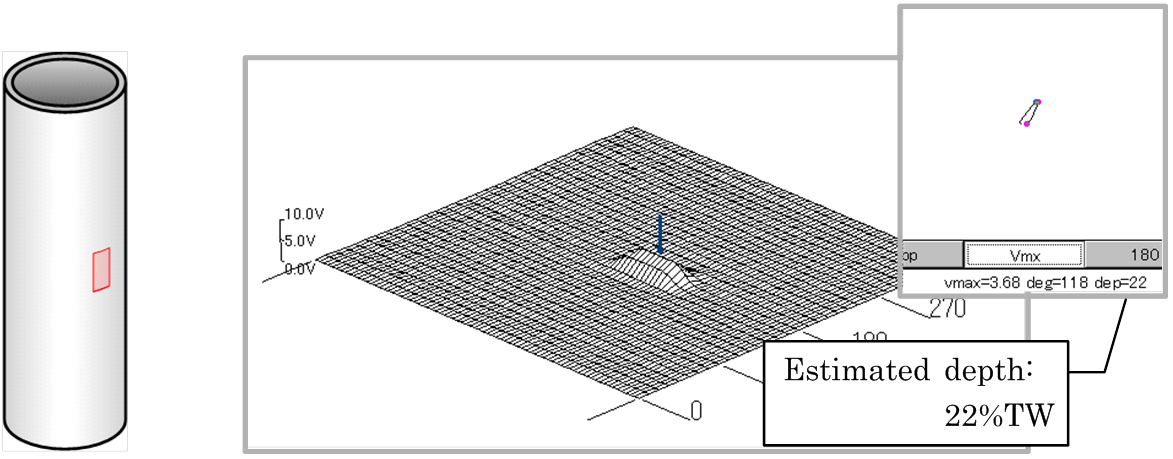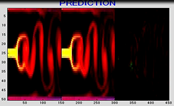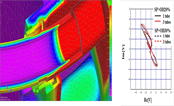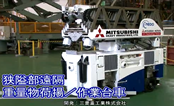Nuclear Engineering, Ltd. (NEL)
Classification
1 - A
In-service inspection (ISI) utilizes ECT techniques to examine SG tubes in PWR, and Dual-Function probes, a kind of bobbin probes which allow high-speed inspection, are most commonly used. NEL has developed and manufactured the Smart Array Probe in 2007 as a next-generation ECT probe for ISI to offer good flaw detectability equivalent to that of rotating probe with a high level of inspection speed. It is equipped with a total of 48 pancake coils (16 on the circumferential and 3 rows of coils in the axial direction). Fig. 1 shows the coil switching pattern of Smart Array Probe. Generally, when transmitter and receiver coil pairs of a transmit-receive type probe match the orientation of a flaw, flaw detectability improves. The Smart Array Probe can achieve high sensitivity without missing any axial or circumferential flaw through a single scanning operation by switching the coil pairs as shown in Fig. 1 by utilizing the application specific integrated circuits (ASICs) incorporated in the probe head to select appropriate transmitter or receiver coils in sequence.
Subsequently, the Smart Array ECT System, NEL’s original ECT system shown in Fig. 2, has been completed by combining the Smart Array Probe with the pusher-incorporated tester “OMNI-200” and tube-walking robot “Pegasys”, both of which were developed by Westinghouse, and NEL3DView analysis software developed by NEL.
OMNI-200 is a pusher-incorporated digital tester and it is capable of both time-sharing and simultaneous multifrequency testing. Pegasys is a lightweight tube-walking robot. Both are high performance equipments developed by Westinghouse which can facilitate SG ECT. Also they are coordinated and controlled by EWS acquisition software called ANSER.
Inspection using the Smart Array ECT System with fast and high accuracy performance instantaneously produces a large amount of data. As the next step, data analysis in an efficient and accurate manner is required. NEL3DView incorporates, in addition to conventional manual analysis functions, three automated capabilities to satisfy this requirement: “automated phase/sensitivity calibration function” which enables automatic calibration utilizing signals from calibration test specimens, “automated signal screening function” which enables the automatic extraction and evaluation of various signals, and “automated depth sizing function” which enables the automatic depth sizing of various wall thinning signals.
It has been confirmed that these equipment and software comply with the JEAG 4208-2012 “Eddy Current Examination for Inservice Inspection of Light Water Cooled Nuclear Power Plant Components”, and it has been confirmed that the inspection system has sufficient practical applicability to actual plants.

(a) Outline view
(b) Schematic view
Fig. 1 Coil switching pattern of Smart Array Probe

Fig.2 NEL’s original ECT system for SG tubes, “Smart Array ECT System”
Phase 3 : Publicly accepted phase
- (1) Components: SG
- (3) Material: Alloy 600 / 690 (TT)
- (4) Condition: Room temperature, in the air
- (1)Capable of performing scanning at a high speed equivalent to that of a conventional bobbin probe
- (2)Having a defect detection capability equivalent to that of rotating probe
- (3)Capable of evaluating a huge volume of array probe data in an efficient and accurate way.
- (4)Complying with JEAG4208-2012.
There are no ISIs with use of Smart Array ECT System. But detectability tests were conducted using test specimens with artificially induced SCC, which are most difficult to be detected in the field. It has been confirmed that Smart Array Probe has enough sensitivity to detect tight cracks as shown below. Also it was demonstrated that there were no glitches with the NEL3DView software functions after going through performance tests using test specimens simulating flaws on SG tubes. It has been confirmed that the inspection system has sufficient practical applicability to actual plants.
- (1)Detectability test of artificial SCCs
Fig. 3 shows the test results. Test specimens (a) - (d) were fabricated by artificially generating SCCs in Alloy 600 SG tubes. They were inspected and analyzed using the Smart Array ECT System. Test specimens (b) - (d) simulating SCC on the expanded tube and expansion transition were manufactured. They were subject to the rolled expansion process before SCC was fabricated. A mock-up tube sheet (TS) was attached to the test specimens used in flaw detection test. They were subject to the destructive examination after the ECT inspection to confirm the crack geometries.
The inspection and analysis results have shown that the Smart Array ECT System is capable of detecting small SCC both in circumferential and axial directions on expansion and expansion transition with TS where there are some difficulties in detecting cracking, as well as on the straight tube section.
- (2)Performance test of analysis capabilities
Performance tests were carried out using test specimens simulating flaws in SG tubes in order to verify the automated screening and depth sizing capabilities of NEL3DView. Fig. 4 presents an example of images generated by NEL3DView. An EDM notch simulating an axially oriented flaw on the outer surface of SG tube supported by broached egg crate (BEC) type tube support plate (TSP) was used to verify the automated screening capability. The result indicates that the software recognized signals from the flaw, although signals were very small.
Wall thinning of SG tube outer surface was simulated to evaluate automated depth sizing capability. It was evaluated that the depth was 22%TW, whereas measurement confirmed the actual depth of 19%TW: the difference was 3% (approx. 0.04 mm). This result indicates that the software is capable of evaluating flaw depth accurately.

(a) Inner axial SCC on straight tube section (Axial mode, 300 kHz)

(b) Inner axial SCC on expansion transition with TS (Axial mode, 300 kHz)

(c) Inner axial SCC on expanded tube with TS (Axial mode, 300 kHz)

(d) Outer circumferential SCC on expansion transition with TS (Circ. mode, 100 kHz)
Fig. 3 ECT signals and destructive test results of artificial SCCs inspected by Smart Array ECT System (Tube diameter : 7/8 inch, Thickness : 0.05 inch, Material : Alloy 600, Inspection speed : 400 mm/sec)

(a) Automated screening
(Axially oriented EDM notch on the outer surface (20%TW) with BEC type TSP)

(b) Automated depth sizing (Wall thinning (19%TW))
Fig. 4 Performance Test Results of Automated Screening and Depth Sizing Capabilities of NEL3Dview
- [1]K. Maeda et al., “Development of Smart Array Probe”, 5th Annual Conf. of Japan Society of Maintenology, 2008.
- [2]K. Maeda et al., “Development of Smart Array Probe”, 27th Annual EPRI SG NDE Workshop, 2008.
- [3]K. Maeda et al., “Development of Smart Array Probe and Introduction of New Inspection System”, 7th Int’l Conf. on NDE in Relation to Structural Integrity for Nuclear and Pressurized Components, 2009.
- [4]J. Akagawa et al., “Field Demonstration of Smart Array Probe and Suitcase Eddy Current System in Japan”, 28th Annual EPRI SG NDE Workshop, 2009.
- [5]K. Maeda et al., “Development and Field Practical Performance of Smart Array Probe”, Maintenology Vol. 10, No.1, 2011.
Japan Society of Maintenology (ejam@jsm.or.jp)






